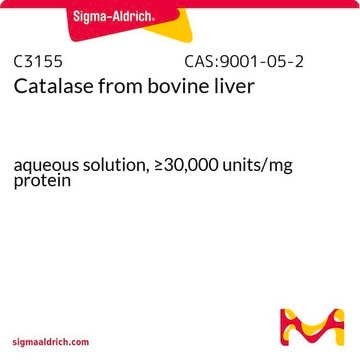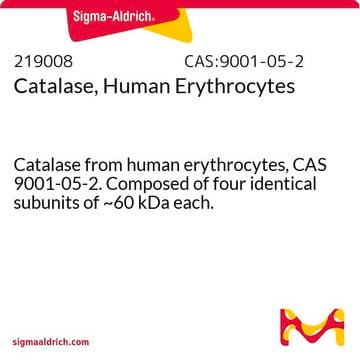Conjugating PEG to catalase is recognized to improve protein stability, leading to an extended circulatory half-life for the enzyme.
C4963
Catalase−polyethylene glycol
lyophilized powder, ~40,000 units/mg protein
Sinonimo/i:
PEG-Catalase
Scegli un formato
Scegli un formato
About This Item
Prodotti consigliati
Stato
lyophilized powder
Livello qualitativo
Attività specifica
~40,000 units/mg protein
PM
PEG 5,000
Composizione
Protein, ~50% E405
Grado di funzionalizzazione
~40 mol PEG per mol protein
Gruppi immobilizzati alla matrice
secondary amine linkage.
Temperatura di conservazione
−20°C
Cerchi prodotti simili? Visita Guida al confronto tra prodotti
Applicazioni
Azioni biochim/fisiol
Confezionamento
Altre note
Stato fisico
Codice della classe di stoccaggio
11 - Combustible Solids
Classe di pericolosità dell'acqua (WGK)
WGK 3
Punto d’infiammabilità (°F)
Not applicable
Punto d’infiammabilità (°C)
Not applicable
Dispositivi di protezione individuale
Eyeshields, Gloves, type N95 (US)
Scegli una delle versioni più recenti:
Possiedi già questo prodotto?
I documenti relativi ai prodotti acquistati recentemente sono disponibili nell’Archivio dei documenti.
I clienti hanno visto anche
-
I would like to know the function of PEG with the catalase for this product.
1 risposta-
Utile?
-
-
What is the Department of Transportation shipping information for this product?
1 risposta-
Transportation information can be found in Section 14 of the product's (M)SDS.To access the shipping information for this material, use the link on the product detail page for the product.
Utile?
-
-
What can I use to solubilize Catalase-polyethylene glycol, Product C4963?
1 risposta-
It is soluble in water at a concentration of 1 mg/mL.
Utile?
-
-
What is the solution stability of Catalase-polyethylene glycol, Product C4963?
1 risposta-
We generally recommend preparing fresh solutions of Catalase-PEG. If stock solutions must be stored, we recommend first dissolving in water, then diluteing with an equal volume of glycerol. This 50% glycerol solution may be kept in the freezer at -20°C. Aqueous solutions held at 37°C were found to lose approximately half of the catalase activity after about 10 days.
Utile?
-
-
What is the specific activity of Catalase-polyethylene glycol, Product C4963?
1 risposta-
The certificate of analysis on our website will have lot-specific activity information.
Utile?
-
Filtri attivi
Il team dei nostri ricercatori vanta grande esperienza in tutte le aree della ricerca quali Life Science, scienza dei materiali, sintesi chimica, cromatografia, discipline analitiche, ecc..
Contatta l'Assistenza Tecnica.










